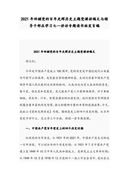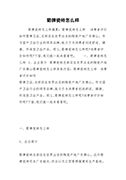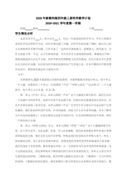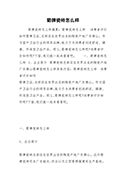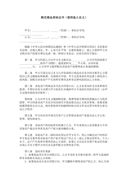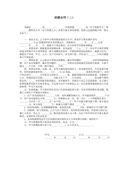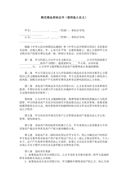Module 2 Friendship(精选3篇)八年级英语教案
Module 2 Friendship(精选3篇)
Module 2 Friendship 篇1
一. 教材分析
1 《新标准》英语采用发现式语法学习法: 呈现---提问---发现---总结, 培养学生自主学习的能力。宾语从句是初中阶段较难掌握的,在jefc教材中出现在九年级,现提早了一个学期,所以难度较大。这需要老师很好地设计课堂教学活动。
2. 本模块以友谊为话题, 通过听力、对话和阅读材料的学习介绍了宾语从句。友谊是同学们较为感兴趣的话题,也与他们自身经历相关。借助友谊展开话题讨论, 同时培养学生关爱他人的情感。
二. 学情分析
1. 知识基础:部分学生缺少丰富的语言基础,对某些任务的完成有一定的难度。
2. 思维能力:有较强的记忆力和模仿能力,有待培养知识的扩展运用能力。
3. 认知心理:有较强的求知欲和表现欲,部分学生存在不自信,羞于表现等思想顾虑。
三. 教学目标
1. 语言技能目标:
听:能听懂用宾语从句表述的意义。 说:能运用不同宾语从句来询问和表达友谊。
读:能读懂阅读文章,理解语篇主题和细节。 写:能用宾语从句来写与友谊有关的短文。
2. 语言知识目标:
1) 能利用宾语从句讨论与友谊有关的话题。正确使用宾语从句的三种句式。
2) 能够理解下列单词和词组:a couple of, junior high school
3) 能够正确使用本模块中出现的四会词及短语。
3. 情感态度目标:
1) 通过对友谊的交流,掌握如何与他人交朋友,理解自己生活中情感影响的重要性。
2) 引导学生与他人合作,相互帮助,共同完成学习任务,尽情享受学习的乐趣。
4. 学习策略目标:
1) 自主学习 能够结合个人的情况预习教材和拓展。
2) 合作学习 能够与同学交流学习心得体会,共享学习策略。
3) 通过合作讨论、游戏、竞赛等多种活动形式,体现在用中学,学而能用的原则。
4) 能利用网络上的学习资源查找信息,用所学内容进行真实交际。
四. 教学重点与难点
教学重点: 正确运用宾语从句描述友谊。
教学难点: 宾语从句的引导词、语序及时态。
五. 突破途径
1. 利用多媒体, 让学生在歌声中感受语言,在轻松愉快的video欣赏中输入语言,在合作学习、游戏、竞赛等活动中巩固语言。
2. 整合教材, 对教材的内容进行适当的补充、删减、调序。以话题为核心,设计多种任务活动,把知识点化难为易。将知识不断滚动、内化和外延。
3. 注重评价方式和鼓励措施,创建并使用学生“成长档案袋”。
六. 教学过程
period 1 unit1 can you tell me where you’re from?
step 1 warming up and leading-in
1. let’s sing the song “where are you from?”
2. fill in the blanks according to the song.
eg. 1) tony sings that he’s from china ( 一共4句)
设计意图 在学生进教室时播放一首与新授知识有关的轻松活泼的歌曲 where are you from? 既是为了活跃课堂气氛,激发学生的学习兴趣, 又是为了能很快进入主题can you tell me where you’re from?
step 2 pair work
1. where are you from? 2.where is your good friend from?
s1: where are you from? s1: where is your good friend from?
s2: i am from… s2: my good friend…is from…
s1: s2 says that he / she is from… s1: s2 says that …
设计意图 联系学生生活实际,体现用中学原则。用地图操练巩固目标句型---that引导的宾语从句。
step 3 group work
1. say something about my good friend sally.
2. report
s1
has heard that sally…
s2
knows that sally…
s3
says that sally…
i
think that sally…
设计意图 通过谈论熟悉人物 sally, 进一步加强目标语的操练。同时,相互交流和帮助又培养了合作精神。
step 4 presentation
1. free talk
eg. have you ever made telephone calls?
who do you usually call?
2. listen and find out:
what do ann’s mother and bill talk about on the phone?
(事先交代情景: ann’s classmate bill called ann. but ann wasn’t in. ann’s mother answered the phone.)
expressions of making telephone calls:
hello! could i speak to ann, please?
i’m afraid she isn’t here right now.
can i take a message for you?
this is bill.
i’ll give her the message…
设计意图 新语言项目在情景中自然呈现,通过多媒体演示, 比较中、英文打电话的不同用语,引导学生判断、总结, 从而达到理解、学习并运用语言的目的。充分体现了学习的过程。
step 5 practice
1. listen and find out how many people you hear. (turn to page 10-1)
2 . listen and number the order. (turn to page 10-2)
3. make a telephone call.
mr. wang telephoned father. but father wasn’t in. you answered the telephone.
(用两只电话机让学生在课堂上表演)
4. u3 activity 5, 2, 3, 4
设计意图 在常规听力练习中进一步提高学生听的能力,在尽可能真实的情景中巩固打电话用语。
step 6 presentation why does sally call chen huan?
设计意图 激发求知欲望。顺利进入新课的学习。
step 7 listening and reading: (turn to page 10-3)
1. listen and answer the questions:
1) how many persons are there in the dialogue?
2) where are they?
2. read and answer (必须用宾语从句回答)
1) what does chen huan say? he says that…
2) what does sally say? she says that …
3. read and check (√)the true sentences. (turn to page 11-4)
设计意图 听读两方面入手,由易到难,层层推进,重视对学生学习能力和技巧的培养。
homework
1. listen and read after the tape for 15 minutes.(p10-3)
2.通过因特网等途径课前收集有关运动员刘翔的资料。
3.给好朋友打个电话,告诉他/她你喜欢做什么。
设计意图 1.英语是一门语言,而语言是用来交际的。只有多听、多读,才能让我们的英语说得更加流利,掌握得更加牢固。
2. 让学生学会一切可利用的资源来获取更多的学习信息。学习活动由课堂向课外延伸。
period 2 review unit 1 and finish unit3 ( 2,3,4,5)
(教师准备两只话筒和一个抽奖箱。)
step1 revision
1. match the words with their meanings.
2. ask and answer the questions about the words in the box. (turn to p11-5)
设计意图 由单词的复习过渡到句子的复习,既培养学生在语境中理解、识记单词的能力,又为新课的学习起到较好的铺垫作用。
3. funny time
教师准备好一个抽奖箱,箱子里事先放入一些写有活跃气氛的简单句的纸条。两个学生一起上去,一个在箱子里抽取一张纸条,大声读。另一个学生重复。让学生们在笑声中复习知识。
step 2 presentation interview your teacher
假设XX年后,你参加工作,当了一名记者, 回来看望老师。学生自由向老师提问, 老师重复学生的问题, 很自然地引出新知识---疑问句的宾语从句。 eg.
s1: miss ni, do you still like teaching english?
t: s1 wants to know if i still like teaching english. i’m glad to tell you that i like teaching english very much.
设计意图贯彻从师生交流到生生交流的原则,在体现学生自主学习的同时,注重教师的示范作用。
step 3 practice
eg. please help the old granny. something is wrong with her hearing.
man: are you tired?
old granny: what does he want to know?
(此处暂停, 让学生用宾语从句回答, 然后继续播放, 核对答案。)
woman: he wants to know if you are tired. tell him if you are tired.
man: why are you tired?
old granny: what does he want to know?
(又暂停, 让学生用宾语从句回答后继续播放,核对答案。)
woman: he wants to know why you are tired. tell him why you are tired.
设计意图 1) 在学新知识时, 适当的机械操练是十分必要的。特别是对部分语言能力相对较弱的学生来说,在机械操练中体会、琢磨并理解新知识是很有效的。
2) 德育渗透,融思想教育于语言教育,培养学生尊敬老人,助人为乐的精神。
2.回到课本read activity 3 again and find what chen huan asks.
3.pair work 谈论学生自己的的爱好。
设计意图 由易到难:从机械操练到课内语言重复再到学生实际问答,最后拓展到课外。
from
shanghai
birth
1983.7.13
height
1.88m
weight
74kg
sports
110m hurdles
step 4 talk about liu xiang
eg. s1:liu xiang was born in shanghai.
s2: what does s1 say?
s3: he/she says (that) liu xiang was born in shanghai.
step 5 group work
1. discuss
what else would you like to ask liu xiang? 屏幕上是滚动出现的有关运动员刘翔的照片。
2. report
in our group
s1 wants to know if liu xiang ... s2 asks whether he ...
s3 wonders wh... i would like to know if…
设计意图 展示学生熟悉的、崇拜的人物的照片, 激发学生的学习兴趣。由于是学生崇拜的人物,因此学生也更乐于参与到英语学习中来。此活动在提高学生积极性的基础上,培养了他们团结协作的精神,当然也非常巧妙地让学生在活动中操练语言,巩固了本模块的主要句型。
step 6 a face-to-face interview
suppose liu xiang has come to jinhua. you are a reporter from radio zhejiang. now there is a press conference(记者招待会). try to make a face-to-face interview with liu xing.
设计意图 设计采访活动能激发学生的想象力和创造力,培养学生用英语思维的能力,实现了学以致用的目的。能充分发挥学生的主体意识,培养学生收集信息的能力。能扩大学生的知识面,并在完成作业过程中增强对名人、对民族英雄的钦佩之情,进而产生学习名人、民族英雄精神的思想。
homework
1. (二者选一) a: write a dialogue about the interview with chen huan.
b: write a dialogue about the interview with liu xiang
2. workbook 3, 4, 5
设计意图 分层次作业,鼓励有能力的学生学会利用词典来增加词汇量。
period 3 unit 2 friendship
step 1 warming up : enjoy the song “friends”.
设计意图 让学生在歌声中感受语言,在轻松愉快的语言活动中输入语言。让他们在做中学,在玩中学, 在唱中学,在快乐中学习。
step 2 presentation
1. what do you think of when you see this picture? (laugh, bright, friends, not lonely, happy…)
设计意图 教学生词,为下面的讨论做铺垫。
2. discuss
1) when was the last time you felt unhappy?
2) who did you tell when you were unhappy?
3) what did you do to feel better?
设计意图 通过对这3个问题的分组讨论,使学生对所要了解的阅读材料的相关背景知识有一个感性认识,减少阅读障碍,为学生理解材料打下良好的基础。
step 3 read and answer
1.fast reading
1) who was the writer?
2) what changed the writer’s life?
3) how was the writer at last?
设计意图 1.在阅读前设置问题,能有力地激起学生的阅读欲望。
2.用快速阅读来培养学生整体获取信息的能力,以适应高速发展的信息社会的需要。
2.careful reading
(turn to page 13 –activity 5)
设计意图 1.分步阅读使学生有充足的语言输入,从而有利于学生进行目标语言的输出。
2.理清思路, 获取细节的信息, 培养学生的细读能力, 符合循序渐进原理。
3.重点理解课文中的目标语句。
step 4 discuss (turn to page 13 –activity 6)
1.what gift have you ever got? 2.why is the opening surprising?
3.how does zhang bei describe her feelings? 4.what advice does she give?
设计意图 进一步熟悉课文,整体理解课文。
step 5 a guessing game
假设班里某个同学的好朋友就在教室里, 请他/她到前面来, 回答其他同学的提问, 猜出这位好朋友。.当然,猜测时学生必须用宾语从句提问。
eg. could you tell me whether your best friend is a boy or not?
i want to know if he / she sits in row…
i wonder if he/she wears…
i guess that…
设计意图 学生喜欢的游戏可以唤起学生的积极的思维活动, 挖掘他们学习英语的潜在能力。将知识融于游戏中,既可以调动学生说的欲望,同时又培养了他们的注意力和记忆能力。而且猜的游戏能使上下环节过渡自然,使整堂课的结构紧凑、连贯。
step 6 free talk
1.who is your best friend?
2.how did your friendship start?
3. what did you do together to have fun?
4.what could change things?
设计意图 适度自由的交际不仅可以为学生创造一个说英语的环境,激发学生说的愿望,还可以复习所学知识。为写做铺垫。
homework
1.write a passage about someone or something which changed your life. ( including3~5 object clauses.)
2.listen and read after the tape for 15 minutes.(p12-2)
设计意图 初中生不仅要发展听、说、读的能力,而且写的能力也不能忽视。从模仿开始,在长期的锻炼下,相信学生以后会写出流畅的英语短文。
period 4 review unit 2 and finish unit 3 (1,6,7,8)
step1 memory challenge
(have a competition between boys and girls)
1. could you tell me? how old was zhang bei at that time? 先将两句合并成一句, 然后回答。
could you tell me how old zhang bei was at that time? yes. she was 13 years old. ……
2. do you know? can you find the answers? 先将两句合并成一句, 然后找答案并连线。
设计意图 新课标指出,学生是学习的主体,不应该以教师的带读来代替学生的自己的感悟与实践,而应该让学生通过游戏、比赛等活动自己来理解感受,最终自然习得。此活动运用学生的好胜心理,训练了学生的记忆能力,也调动了学生的积极性, 同时也复习巩固了unit 2中出现的一些重点句型。
step2 watch a video
be sunwukong and try to find the difference between orders.
1. what is the problem? i wonder what the problem is. ( 一共6组句子)
操作说明 第一步: 让学生观看vcd。
第二步: 学生讨论并小结。特殊疑问句作宾语从句: 1.用疑问词引导。 2.从句用陈述句语序。
第三步: 再让学生观看video, 此次边看边练习, 中途要使用暂停。如:
1. what is the problem? i wonder 暂停,让学生回答what the problem is.
设计意图 1.video 是学生比较容易接受的语言形式,有一定的趣味性,在欣赏的过程中及时思考,也具有一定的挑战性。
2.借助多媒体演示,把枯燥无味的学语法过程趣味化。让学生通过仔细观察、对比来发现目标语言现象,突破教材的难点--宾语从句的语序。而且注意语言的滚动,增加学生的语言积累。
step 3 discuss
1. do you have friends on the internet?
2. what do we call friends on the internet in english? (e-pals)
3. how often do you write to your e-pals / pen friends ?
4. which do you like best, a pen friend , an e-pal or a friend in real life? why?
设计意图 根据学生的生活实际,以及p17 – around the world. 设计各种有趣的问题,让他们讨论,充分调动学生的积极性,发挥他们的主体性,让他们在学习中生活,在生活中学习,以达到教与学的最佳结合。
step 6 enjoy “be kind to all of your friends” and answer
1.could you tell me whether it is a rap or not?
2.do you know what it is about?
临近下课, 欣赏一首歌,既把整堂课的气氛推向高潮,又为下面的讨论和写作做好了铺垫。
step 7 pair work
what should a good friend be like? i think that a good friend should…
homework
write an e-mail to tell your friend what a good friend should do.
eg. i think that a good friend should … my mother told me … my teacher said …
设计意图 在学生感知大量语言信息材料的基础上,进行归纳总结以达到语意重建, 从而进一步提高语言表达能力。
period 5 finish module task and workbook
step 1 homework show 用幻灯片展示部分学生的家庭作业。(不一定是优秀学生的作业。)
设计意图 鼓励学生尤其是学困生,对自己有信心,不要放弃英语。
step 2 presentation would you please help the old granny again?
设计意图 突破难点:主句过去时, 从句也要改用相对应的过去某种时态。
step 3 brainstorming
1.what did zhang bei say? she said that ……
2. what did the boy say? he said that ……
设计意图 利用u2中的语言材料,复习操练宾语从句。
step 3 practice and think
操作说明 1. 一起做课件中的练习。
2.看书。turn to p148 “guide to language use”---宾语从句
3.讨论总结。
设计意图 1.语法学习是语言学习中必不可少的环节。 在语法教学中,有必要把学生接触过的某一类语法现象的点点滴滴进行归纳,由点到面,建立系统。
2. 让学生自己找规律归纳总结宾语从句。这一过程培养了学生独立思考的能力。而且学生自己总结出来的规律就会记牢,不易犯错。
step 4 do exercise : workbook 1, 2, 6, 7, 8, 10 and 11
设计意图 通过适量的练习,巩固强化所学知识。进一步测试学生的笔头输出语言情况。在这一过程中,积极思考,及时反馈。在反思、顿悟和自醒中,不断调整自己的学习策略。
step 5 problem solving
name
difficulties
solutions
设计意图 在传统的教学中,老师总是充当主角,罗列出课文的重点、难点进行讲解,学生只有被动接受,学习主动性受到很大的限制。设计这个环节是为了帮助学生提高学习的主动性,学会自主学习并大胆质疑。
step 6 questionnaire (turn to page102-9 )
can you tell me if you are a good friend?
step 7 discuss
1. how can you be a good friend?
2. tips on friendship(友谊秘诀)
3. what can we learn?
设计意图 这3个问题的讨论为学生提供了一个进行广泛思考的机会。由于答案的开放性,学生的思维得以拓展、延伸。
homework: making a wall newspaper about friendship. ( including three to five object clauses.)
设计意图 1. 设计友谊墙报。这一任务贴近学生真实生活,引起学生的共鸣和兴趣,激发学生的求知欲,促使学生产生学习的内驱力,充分发挥学生的想象力和能动性,主动地融入到语言学习活动中去。体现了用中学,学了用的任务型理念。
2. 在本模块各单元的学习中,通过“词――句――篇”的层层推进,大部分学生已能初步完成了单元的核心任务,学困生也在小组活动、全班活动中获取了不少帮助,在不同基础上都获得了进一步的发展。
Module 2 Friendship 篇2
复习要点 词汇:见书后附录 一、 重点词组 hold the line (= hold on) 稍等,别挂断。 call back 打(电话)回来 right now 现在 take a message 捎个信儿 leave a message 留个信儿 whether…or not 是否 in fact 事实上 a couple of…几个,若干 in a week 一周后(用于将来时) miss one’s close friends 想念某人的好朋友 be different from… (反义:the same as…) 与…不同 (反义:与…相同) make friends with sb. 与…交朋友 good luck with…祝…好运 bring sb. for a visit to some place 带某人来某地参观 wait for sb. (to do sth.) 等待某人做某事 invite sb. to do sth. / invite sb. to some place 邀请某人去做某事/去某地 talk with/to sb about sth. 和某人谈论某事 by the way 顺便说一下 feel happy / unhappy / better 感觉快乐/不快乐/更好 take place 发生 far (away) from some place 离某地远 be afraid to do sth. / be afraid of sth./doing sth. 害怕做某事 every time + 时间状语从句 每次 want (sb.) to do sth. 想让某人做某事 worry about… 担心… sit at the desk / work at the computer 坐在桌旁/在电脑前工作 as usual 像往常一样 at that moment 在那时 enter the room (注意enter是及物动词,后不加介词。) 进入房间 turn back 转过身 day by day 一天天地 be close to… 离…近 smile at sb. 对…微笑 laugh at sb. 嘲笑某人 it doesn’t matter (that….). …….没关系 not …any more / not…any longer 不再 give advice / take advice 提出建议/接受建议 look for… 寻找… in town / in the country 在城镇/在乡村 二、 重要知识点 ² what does it feel like? 用来询问对方对某件事的看法。 e.g. what does it feel like to be at school in america? 在美国上学感觉如何 ? 类似的表达还有what do you think of…? / how do you like…? ² 辨析sometime, some time, sometimes, some times sometime某个时候,表示时间点,多用于将来。 i believe that my dream will come true sometime in the future. some time一段时间,表示时间段,多用于现在完成时。 he has been here for some time. sometimes有时,表频率,多用于一般现在时。 it’s sometimes hot and sometimes cold. some times若干次/若干倍 i have been to sydney some times. ² 辨析lonely 与alone lonely是adj. 表示“孤独的”,是内心的感受,而 alone可做adj.或adv.,表示“独自一人地”,是现实的状况。 e.g. she felt lonely because she had no friends here. 她因为在这儿没有朋友而感到很孤独。 the old woman lives alone because her daughter is abroad. but she is not lonely because we often go to see her. 这位老奶奶一个人独自居住,因为她的女儿在国外,但她并不孤独,因为我们经常去看望她。 ² 辨析other, the other, others, the others 区分这四个词,只需注意以下两点: 1.没有the表示“别的,其余的”;有the强调“其余所有的” 2.若other后没有s则后面往往还有名词(单数情况除外),若other后有s则后面不加名词。 另外,another与这四组词都不相同,它表示“又一个,再一个”,所指事物没有范围,而上面那四组词则都是将事物分成了两大部分。 e.g. english is spoken not only in the uk and the usa, but also in many other countries. (这里不强调除英美外,其余所有的国家都说英语,所以不加the,另外,后面有countries,所以other不加s。) the old lady has four sons. one is in canada, the others are in america. (这里强调除一个在加拿大外,其余所有的都在美国,所以加the,另外,other后面没有名词,所以加s。) would you like another cup of tea? (这里指再来一杯,没有范围。) ² 当adj.修饰不定代词(something, anything, nothing, everything)时,adj.要后置。 e.g. i have something important to tell you. he has nothing new to say. ² 辨析surprising与surprised surprising 意为“令人惊讶的”,修饰物或事;而surprised意为“吃惊的”,修饰人。 e.g. the news is surprising. i’m surprised at the news. 类似的单词还有exciting (excited), tiring (tired), pleasing (pleased), amazing (amazed)等。 ² 掌握一些固定电话用语: is chen huan there? 请问陈欢在吗? is that chen huan (speaking)? 您是陈欢吗? may i speak to jack, please? 杰克在吗? i’ll call back later. 我一会儿再打。 this is sally (speaking). 我是sally。 who’s calling, please? 请问您是那位? hold the line, please. 稍等,别挂断。 sorry. he isn’t here right now. 对不起,他现在不在。 can i take a message? / can you leave a message? 我能捎个信儿吗?/ 您能留个信儿吗? i’m afraid you have the wrong number. 恐怕您打错了。 三、 语法 objective clause宾语从句 宾语从句可根据引导词分为三大类: 1.当从句是陈述句时,用that引导,that可省略,语序不变。 u trees improve the air. betty thinks (that) trees improve the air. u it will snow this winter. i hope (that) it will snow this winter. u there is a good film tonight. jack said (that) there was a good film on that night 2.当从句是一般疑问句时,用if 或whether引导(若句尾有or not,则用whether,语序由原来的疑问句语序变为陈述句语序。 u will they plant trees on sunday? he doesn’t know whether they will plant trees on sunday or not. u have you seen him before? i can’t remember if i have seen him before. u was she late for class this morning? he asks if she was late for class this morning. u did she study hard? i didn’t know whether she studied hard or not. 3.当从句是特殊疑问句时,用原来的特殊疑问词引导,语序由原来的疑问句语序变为陈述句语序。 u how can we help protect the environment? he asks how we can help protect the environment. u why do they like computer games so much? i can’t understand why they like computer games so much. u when will we hold the sports meeting? do you know when we will hold the sports meeting? u where did the accident happen? tom asked me where the accident happened. 掌握宾语从句,尤其要注意以下三个方面: 1.引导词 2.语序 3.时态:若主句是现在范畴的时态,从句用任何时态均可。 若主句是一般过去时,从句必须用过去范畴的时态。 exercises(练习): 1) your father is a doctor. (i know) 2) what’s he going to do? (he doesn’t know) 3) should she go to the party? ( she can’t decide) 4) when did he last see his old friends? ( he can’t remember) 5) do you like living in china? ( can i ask you ) 6) what does she usually do? ( tom asked ) 7) where did mike study two years ago? ( do you know ) 8) do you do your homework in the evening? ( could you tell me ) 9) what does he do at weekends? ( i wonder ) 10) how do things work? ( thomas edison liked to find out )
Module 2 Friendship 篇3
unit 3 language in use一、总结宾语从句:(一)由wether /if 引导的宾语从句如果我们想要表达一个不确定的概念,比如说“记不清、不知道、想知道”等等,就要用whether/if 表示。从句后面还有or not 的话,一般要选用whether, 构成whether ….or not的结构。1.do you know if sally maxwell has arrived?2.can i ask you if you miss the uk?3.i asked your secretary whether she could come or not.练习:1.他问我是否有空。he asks me _____________________.2.is the post office over there ? he wanted to know. 合并成含有宾语从句的复合句子_______________________________________________________________(二)由that 引导的宾语从句当谓语表示肯定的概念时,如“希望、相信、知道、说”其后面的句子一一般用that引导。1.i’ve heard that you play in your school orchestra.2.i know that foreigners find china very different from their own countries.练习: it is good to do morning exercise . i think.合并成含有宾语从句的复合句子_______________________________________________________________(三)由疑问代词where /who/how/when/why引导的宾语从句1.can you tell me where you are from?2.i don’t know who will come.注意:在疑问词引导的宾语从句中,一定要用陈述句语序。练习:选择填空( )1 miss green didn’t tell us ___ in .a where does she live b where did she live c where she lives d where she lived( )2 i want to know _____ the day after tomorrow.a what he will do b what he did c what will he do d what did he do( )3 i’d like to know _________a when will he give back the book b whether has he received higher education c that she has been busy d whether she will join in our english evening( )4 i want to know ____ do to help them.a what can i b what i can c how i can d how can i ( )5 the teacher asked jim ____ he was late for school again.a why b when c where d how( )6 a :who knows _____ he is ? b: they say he is much better these days.a what b who c how d where( )7 could you tell me ____ we will have the picnic this weekend?a that b when c what d where( )8 i don’t know ____ he still lives there.a where b what c when d whether翻译1我知道他是谁。i know ___________________________.2 李鹏想知道图书馆在哪儿?li peng wanted to know _________________________.(四)宾语从句的否定要前置eg: i think. he isn’t right.构成宾语从句i don’t think he is right.练习:1 我认为你的答案不对i ______________ your answer is right.2( )he is so busy . i ___ he ___ time to play with you.a think, hasn’t b don’t think , has c think, has d don’t think; doesn’t has3 i think it is going to rain.变成否定句_____________________________________________________________(五) 宾语从句中要注意人称和时态eg: 把下列句子合并成含有宾语从句的复合句子tom asked me, “ how can i get on well with my classmate?” ¬¬¬¬¬tom asked me how he could get on well with his classmate.练习:the children asked their mother, “can we eat those apples?”the children asked their mother _____________eat those apples.(六) 如果宾语从句说的内容是真理就一定用一般现在时。our teacher told us the earth _goes_ round the sun.二.重点和难点1 look for 寻找2 find out找出 ★3what does it feel like to be at school in china?在中国上学感觉如何?4 at first 起初5 take a long time 花费很长时间6come over 过来7 i’m afraid that you have the wrong number. be afraid +that 从句 8 move to 搬到9 enjoy doing sth喜欢做某事

